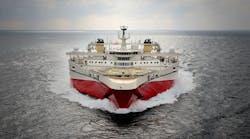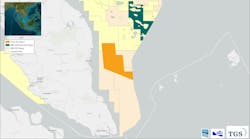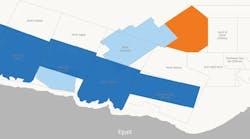Microseismic monitoring is an emerging technique in the petroleum industry that will allow better reservoir management as well as improve reservoir recovery. The technique is based on the idea of deriving vital additional information about a reservoir by recording and processing so-called microseismic events that occur throughout the production life of hydrocarbon reservoirs.
The locations of these small earthquakes inside the reservoir will provide insight into the behavior of the reservoir over a period of time and will also provide the necessary information for the interpretation of reservoir stability, fracture network characterization, and fluid flowpaths. The quality of such interpretations depends mainly on the quality of the microseismic data. Yet, in order to achieve the best possible data quality in a microseismic monitoring experiment, it is of paramount importance to spend time on careful pre-survey planning and pre-engineering.
Reservoir management
Microseismic events (ME) are small earthquakes that occur throughout the production life of hydrocarbon reservoirs. They are mainly induced by petroleum extraction and associated recovery techniques (water, gas or steam injection) or by hydro-fracturing experiments.
These events have their origin in the reservoir or in its vicinity at small fractures, most of which are pre-existing, and result from local stress changes. There are many possible conclusions regarding the possible behavior of the reservoir that can be drawn from microseismic observations, some of which are listed as follows:
- Active faults: Since ME occur mostly on pre-existing fractures or faults, the computation of their location provides a way of delineating active faults. It is therefore possible to obtain the geometry and position of these faults and to determine the active fault network in the reservoir, from a sufficient number of ME recorded over a long period of time.
- Fluid-front movement: The injection of gas and water during production or during hydro-fracturing operations induces high fluid pore pressure changes at the fluid front, triggering ME. By examining the change in location of these events in time, a real-time 3D picture of the fluid-front movement inside the rock mass can be achieved. Furthermore, the microseismic data will give very useful information about the preferred flow paths and will indicate possible flow anisotropy.
- Reservoir stability: Since seismically active zones are characteristic of large stress field changes, ME locations can also provide information about the stability of the region in which they occur. This can be either in a particular reservoir level or around a specific well. On the basis of this information, reservoir compaction problems can be better understood.
- Other effects: Analysis of the waveforms of ME recorded at different stations allows the computation of the stress and energy release, the fracture rupture length, and even the focal mechanism.
Interpretation
This list of applications is not complete, but it underlines the fact that the interpretation of microseismicity very much depends on the number of recorded ME, their location and ultimately on the accuracy of the location computation. In other words, only carefully designed microseismic experiments will yield useful additional information about a reservoir and allow new interpretations concerning the reservoir behavior.
Poorly designed configurations will, however, severely compromise the quality of the data recorded. To obtain the best results for a particular field, which should provide accurate event location, crucial design work covering the geophysical and engineering aspects of the microseismic monitoring must be performed.
User's guide
Recent microseismic monitoring projects on land, such as that of Cotton Valley (East Texas), or offshore, such as those of Ekofisk or Valhall (North Sea), have demonstrated the feasibility of microseismic surveys and led to interpretations deduced from the location of the recorded events.
In both offshore cases, the seismic network was an array of six three-component receivers (CGG's SST-500 three-component multi-level tool was used in both cases) deployed in one well. The design of the microseismic monitoring network is a direct result of the best compromise between three imponderables: the available budget, the expected ME, and the associated field characteristics (well details).
Most of the time, ME have frequencies of over 200 Hz, a duration of less than 2 seconds, a local magnitude (Richter scale) of less than 0, and a rupture length of a few dozen meters.
Obviously, these typical characteristics can vary from one ME to the next. Generally it can be said that the weaker the event, the higher its frequency content, the shorter its duration, the smaller its magnitude and the shorter its rupture length. This clearly affects the monitoring network design in that it will depend on the kind of ME to be expected.
Geophysical issues
The monitoring network must be deployed as near as possible to the expected ME location zone, which must be defined as clearly as possible. ME are easily affected or obscured by surrounding noise. As with all seismic events, they will also be affected by the attenuation of their energy during propagation through rock, resulting in a reduction in amplitude.
Even with these considerations, microseismic monitoring has already been applied in different types of geological environments (chalk, granite reservoirs). The offshore microseismic monitoring experiments cited above presented receiver-source distances of a few hundred meters. If the choice between a downhole or surface microseismic network exists, then this distance consideration between receivers and sources becomes important.
Multiple sensors
To gain a good estimate of ME locations, which result from statistical analyses, it is important to have as many different viewpoints of the ME from the monitoring receiver network as possible, i.e. the best coverage. The questions of how many sensors and how many wells arise. Obviously, the answer to both is "as many as practically possible" within budget constraints.
Considering the uncertainties appearing in the data used to locate the ME (P and S-wave arrivals, polarization, etc.), an array of four three-component receivers is the minimum required. Recent microseismic monitoring networks were composed of a string of six sensors in one well and so far this has been the most cost-effective solution.
In the case of permanent monitoring, sensors deployed in different wells scattered across the reservoir could be an alternative and possibly cheaper solution. It would also provide generally better coverage. Good coupling of the tool to the surrounding rock mass is essential in order to record the real displacement, velocity, or acceleration of the rock. Cementing receivers into the well behind casing offers the best coupling.
The longer the monitoring period, the more events will be recorded, and the better the understanding of observed changes in the reservoir will be.
Engineering issues
A substantial effort is also required to achieve trouble-free installation and long-term equipment reliability, yet still obtain optimum geophysical results. Broadly speaking, there are two main categories of deployment:
- Semi-permanent or retrievable deployment: A temporary monitoring period of a few weeks or a few months involves using a wireline to deploy a microseismic receiver array tool into a well in a similar way to that of conventional wireline logging. Engineering issues include borehole casing diameter details, borehole fluid composition, and wellhead pressure control.
- Permanent deployment: Long-term monitoring uses receivers either mounted on tubing or cemented behind casing. In some cases such systems have been in operation for several years.
While engineering issues for permanent deployment are in some respects similar to those for semi-permanent, they require the use of more detailed information and design work involving close liaison starting at the planning stage with a client's drilling/well operations department. Existing wells may be fitted with tubing-mounted receivers during workover.
The technology for this type of installation builds on that used for other permanent downhole sensors such as pressure, temperature, and flow sensors. Installing receivers by cementing them behind casing has advantages over other deployment methods but is only an option for new wells.
Acquisition
A high sampling rate of the data stream in the order of 1 kHz is required to record ME, which are generally of very short duration. This is necessary to obtain accurate P wave and S-wave arrival times used to compute the location of the ME.
ME amplitudes cover a wide range depending on their distance from the receivers and the energy release that causes them. Hence a wide dynamic range recording (96dB) is required. ME event spectra are wider than those generally seen with conventional seismic methods hence a wide frequency range is necessary (50 Hz to 1-2 kHz).
Consistent wave arrival time picking is essential when processing the data recorded by the receivers. This involves having accurate clock synchronization for the whole network. Sampling rate, frequency range and dynamic range are therefore interconnected.
Processing
To use P-wave polarization for locating events, it is necessary to make some orientation calibration shots to determine the direction in which the receiver components are pointing. Normally, this would be done using a conventional seismic source at as many different and evenly distributed source positions as possible. The minimum number, even with good coverage, should be four or five locations.
Microseismic monitoring is a cost-effective way of obtaining a better understanding of a reservoir's state, including the way in which it changes throughout its productive life. With a wider coverage than logging, a more accurate geometrical description than that of conventional seismic and with its intrinsic time-lapse nature, it provides information such as fracture mapping, fluid pressure front, flow anisotropy, reservoir stability, which can enhance reservoir recovery and management.
The chances of success of microseismic monitoring are greatly improved by properly setting out the objectives and designing the survey network. Both must be in accordance with the geophysical properties of the reservoir and the ME and with the engineering aspects of the survey.
Questions that must be answered include: What microseismic events to record? Where will they take place? Will attenuation be a problem? How many wells to monitor? How many receivers to use? What sample rate and frequency range? How long to record the ME's?
To provide optimum results from high quality data, each reservoir will have its own requirements, each possibly resulting in a different microseismic network design.
References
Maxwell, S.C., Young, R.P., Bossu, R., Jupe, A. & Dangerfield, J., 1998. Microseismic logging of the Ekofisk reservoir. SPE/ISRM Eurockྞ, SPE 47276.
Dyer, B.C., Jones, R.H., Cowles, J.F., Barkved, O. & Folstad, P.G., 1999. Microseismic survey of a North Sea reservoir. World Oil, March 1999.
J.T. Rutledge, W.S. Phillips, L.S. House & R.J. Zinno, 1998. Microseismic mapping of a Cotton Valley hydraulic fracture using decimated downhole arrays. Expanded Abstracts, SEG-New Orleans, September 1998, 338-341.
E. Gaucher, F.H. Cornet & P. Bernard, 1998. Induced seismicity analysis for structure identification and stress field determination. SPE/ISRM Eurockྞ, SPE 47324.






